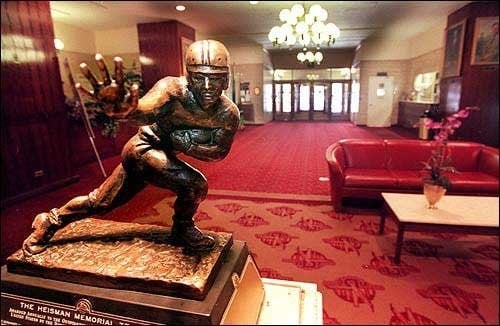
The Heisman Trophy in the lobby of the old Downtown Athletic Club


The Heisman Trophy in the lobby of the old Downtown Athletic Club

Before the now-famous stiff-arm design, the Club Trophy Committee at New York’s Downtown Athletic Club concurred that the traditional cup or bowl seemed too commonplace, lacking in distinction, and in no way emblematic of the athletic talent that was to be honored and immortalized. It was decided that the trophy would be the bronze embodiment of a muscular footballer driving for yardage.
To create this trophy, the DAC commissioned Frank Eliscu, a well-known sculptor and National Academy of Design Prize Winner. He immediately began to work, selecting Ed Smith, a leading player on the 1934 New York University football team, as his primary model. Eliscu prepared a rough clay study that was sanctioned by the DAC Committee, and sent uptown for approval by the head football coach at Fordham University, Jim Crowley, one of the legendary Four Horsemen of Notre Dame. The prototype was set up on a field, and Crowley’s players were asked to assume various positions to illustrate and verify the side step, the forward drive, and a strong-right arm thrust. The artist closely observed these action sequences and modified his clay prototype.

The result was a truly lifelike simulation of a player in action. It was then duplicated in plaster-a preliminary step towards its ultimate production in bronze. The final inspection of the cast was made after a dinner at the McAlpin Hotel on November 16, 1935, attended by Coach Elmer Layden and the entire Notre Dame football team, who had justplayed in a memorable 6-6 tie game with Army before 78,114 fans. Layden, another member of the Four Horsemen, and the Fighting Irish squad, was impressed by the inspired and animated realism of Eliscu’s model-which was especially noted by Wally Fromhart, Don Elser, and Wayne Millner. That evening, the 1935 Notre Dame team put its seal of approval on the new trophy.
Made from an ancient method known as the lost wax process of bronze casting, the completed sculpture weighs 45 pounds, is 14 inches long, 13 inches in height, and 6 inches in width. The final incarnation of the Trophy faithfully depicts a skilled and powerful football player, sidestepping and straight-arming his way to a touchdown.
“It was not one of my best works of art,” said Eliscu. “But it turned out to be kind of like the Statue of Liberty: not beautiful, but it’s dear to people’s hearts.”